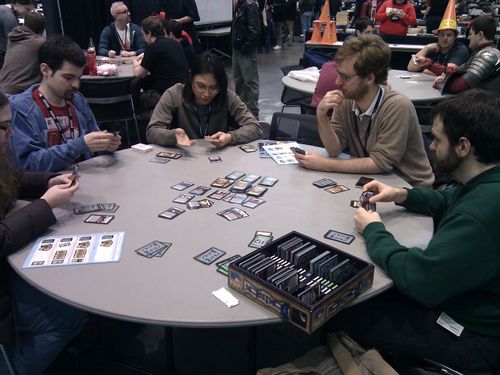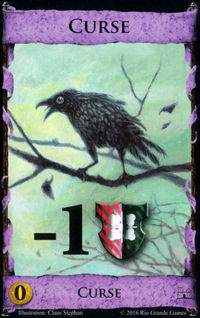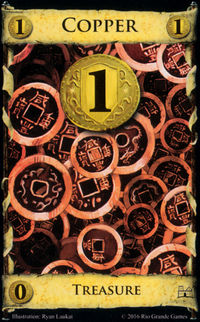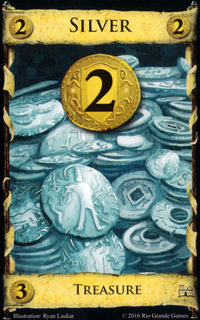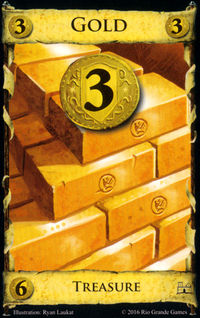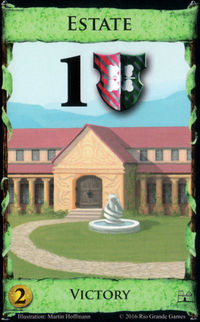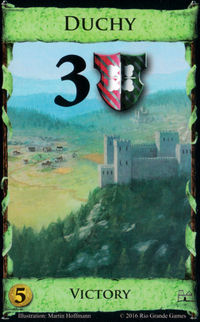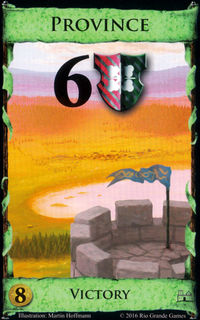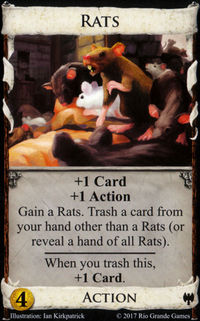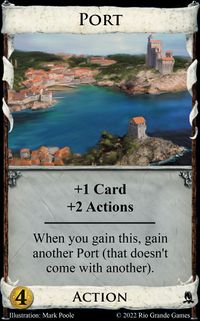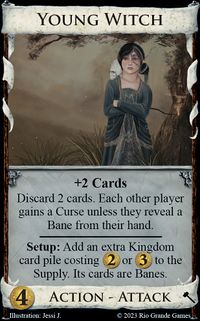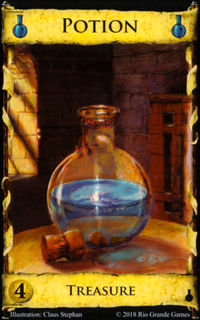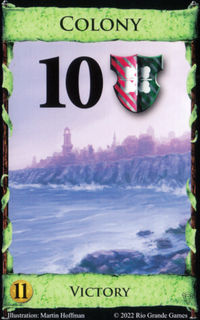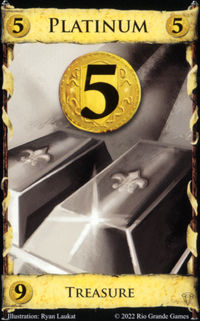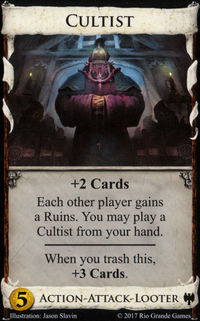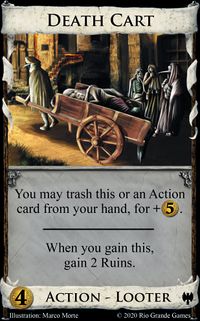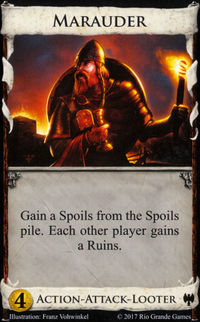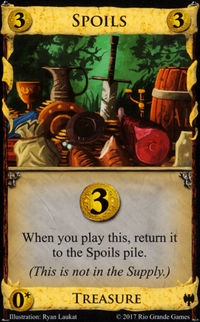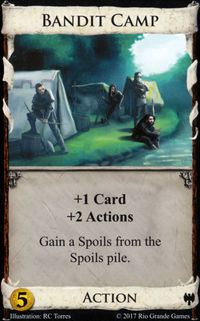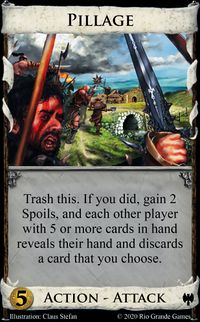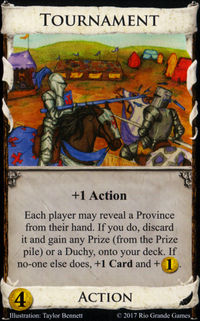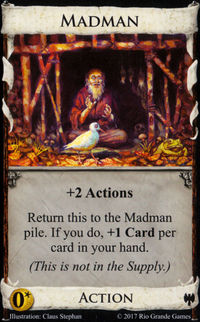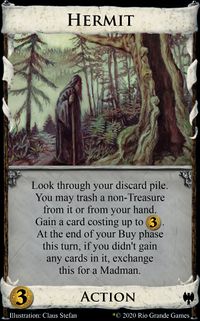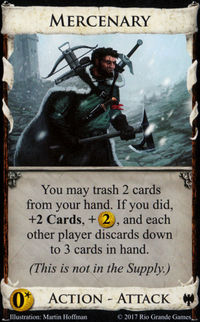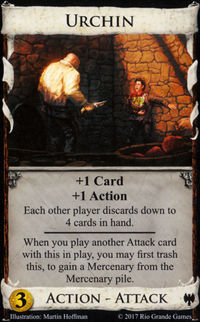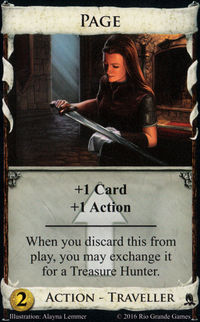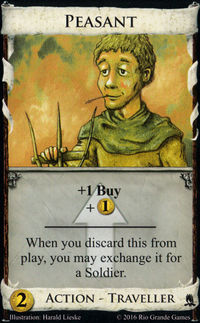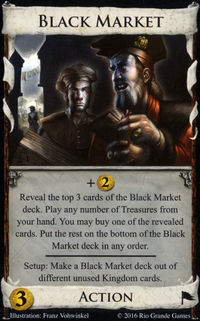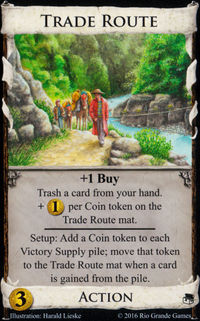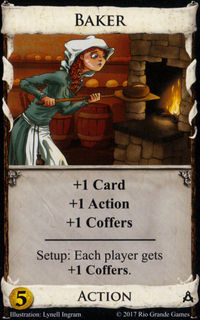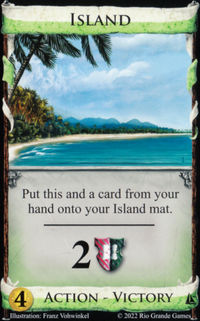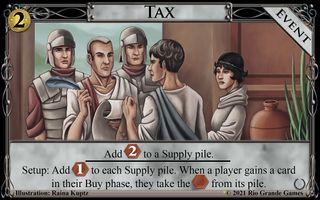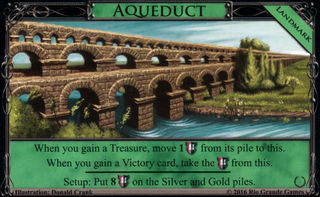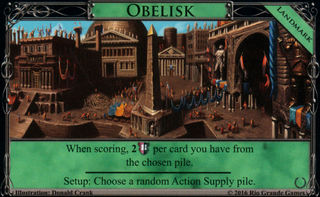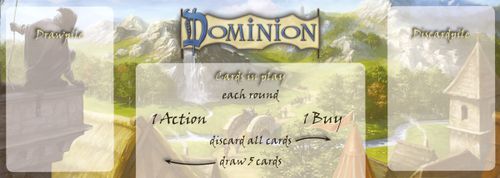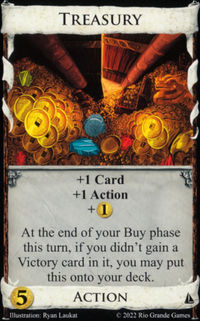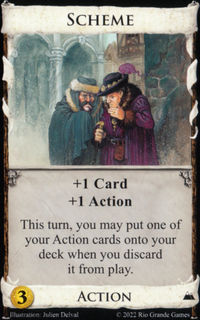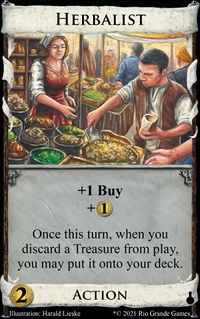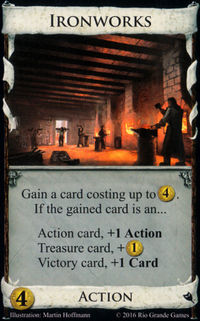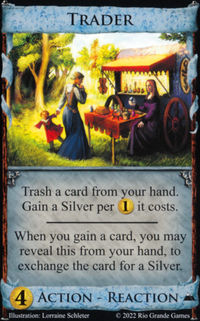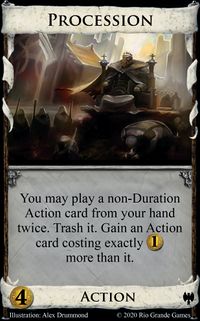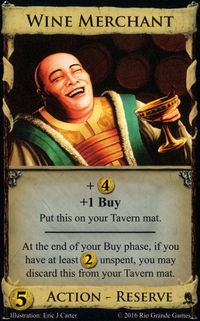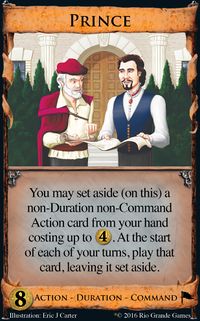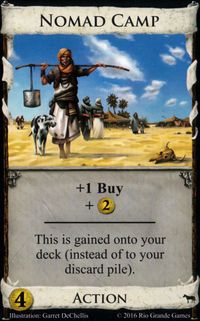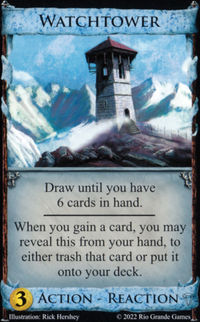Gameplay
This article summarizes the rules of the game of Dominion.
Interpretation and exploitation of the rules and mechanics of the game entail strategy and tactics.
Contents |
Setup
Standard setup
To set up the game, first prepare the cards which constitute the Supply. The Supply normally consists of the 7 basic Supply piles (Curse, Copper, Silver, Gold, Estate, Duchy, and Province) and 10 Kingdom cards. Curse cards are included even if no Kingdom card specifically references them. The 10 Kingdom cards, collectively known as the Kingdom, may be chosen by any method agreed upon by the players. A common method is to select randomly from the Randomizer deck. Alternatively, there are some Recommended Kingdoms that introduce the game and expansions or create interesting decisions for players.
Events and Landmarks may be included as well; like Kingdom cards, these may be selected in any way. It is recommended that no more than two Events and/or Landmarks be used per game.
Finally, mark out the trash pile (typically with the trash card), and give each player a starting Deck consisting of 7 Coppers (from the Supply) and 3 Estates (not from the 8 or 12 in the Supply).
Additional setup rules
Each pile of Kingdom cards in the Supply normally contain 10 cards. Some exceptions include:
- The Rats pile (if in the Kingdom) contains 20 cards.
- The Port pile (if in the Kingdom) contains 12 cards.
- Victory card piles (Kingdom and basic Supply) contain 8 cards in a two-player game and 12 cards in games with more players. (A Kingdom card which is both a Victory card and another type is considered a Victory card.)
- In 2-player games, use one of each Castle; with more players, use all 12 cards.
Certain Kingdom cards will require additional piles to be included in the Supply. Additional piles which may be included are:
- If Young Witch is selected as a Kingdom card, an 11th Kingdom card costing or , designated the Bane card, is added to the kingdom.
- Potion is used whenever any Kingdom card has in its cost.
- The use of Colony and Platinum may be added in games using Kingdom cards from Prosperity; it is recommended that this be decided randomly based on the percentage of Prosperity cards in the Kingdom (see the Prosperity additional rules for more information).
- Ruins are used whenever a card with the type Looter is included in the Kingdom. Specifically, Cultist, Death Cart, and Marauder constitute the Looters.
Some Kingdom cards, if selected for a game, may involve the addition of other piles of cards that are not considered part of the Supply. Since these additional piles are not considered part of the Supply, they do not count towards the game ending condition. For example:
- Spoils are included whenever Bandit Camp, Marauder, or Pillage is in the Kingdom.
- Prizes are used with Tournament, Madman is used with Hermit, and Mercenary is used with Urchin. The two Traveller Kingdom cards, Page and Peasant, each come with four additional piles of 5 cards each that they can upgrade into.
- A Black Market deck is used when playing with the promotional card Black Market.
Some Kingdom cards include additional setup instructions: Trade Route calls for the placement of tokens on Victory card Supply piles, and Baker calls for each player to start with one Coin token. Some cards (such as Island) also require that players be given a special mat to put cards or tokens on.
Some Events and Landmarks include additional setup instruction: Tax adds to each Supply pile, Aqueduct puts 8 ![]() tokens on the Silver and Gold piles, and Obelisk requires the choosing of a random Action Supply pile, among others.
tokens on the Silver and Gold piles, and Obelisk requires the choosing of a random Action Supply pile, among others.
If playing with Dark Ages, each player's starting Estates may be replaced with Shelter cards (see the additional rules for Dark Ages for more information).
Turn Phases
Main article: Turn
Starting with the first player (decided randomly to begin with; after that the player who got the fewest points in the previous game), each player sequentially plays a turn, divided into three distinct phases: Action phase, Buy phase, Clean-up phase (usually abbreviated "ABC"). Once each player has taken their turn, the sequence begins again, one turn after the other, continuing until an end condition is met.
Action phase
Each player receives one Action at the start of their turn, and during their Action phase, they may spend that Action, and any other Actions they receive during their turn, to play one or more Action cards. Note that Actions and Action cards are separate things; Actions are a sort of currency used to play Action cards.
Action cards are the cards that say Action at the bottom of the card. Since (in the absence of Shelters) players do not start the game with any Action cards in their initial decks of 10 cards, a player will usually not have any Actions to play during their first 2 turns. By default, a player may play only one Action card (since they start their turn with only 1 Action), but some Action cards grant the player the right to play one or more additional Actions afterward. It is never mandatory to play an Action card even if you have one in hand; the only exception is when another Action card that you have played instructs you to do so.
To play an Action, the player takes an Action card from their hand and lays it face-up in their play area. They announce which card they are playing and follows the instructions written on that card from top to bottom, except for instructions specifically noted as applying at a time other than when the card is played. The player may still play an Action card even if he is not able to do everything the Action card tells him to do; but, having played it, the player must follow as much of the card's instructions as they can. Furthermore, the player must fully resolve an Action card before playing another one (if he is permitted to play another Action card) or concluding their Action phase. Any Action cards played remain in the player’s play area until the Clean-up phase of that turn, unless otherwise indicated on the card. The Action phase ends when the player cannot or chooses not to play any more Action cards. Generally, a player can only play Action cards during the Action phase of their turn.
Buy phase
Each player receives one Buy at the start of their turn, and during their Buy phase, they may spend that Buy, and any other Buys they receive during their turn, to pay the cost of one or more cards from the Supply, gaining them once paid for. Buys can also be spent to pay the cost of Events, to receive certain effects.
At the beginning of the buy phase, the player may play any number of Treasure cards from their hand, in any order, to their play area. These usually produce some amount of , which is added to any produced by cards played in the Action phase. Some Treasure cards have other effects as well, which are resolved when played in the same way Action cards are resolved in the Action phase. In a game in which Coin tokens are in use, before buying any cards or Events, a player may increase their current amount of by spending any number of Coin tokens. Once a player begins to buy cards and/or Events, they may not play any more Treasures or spend any more Coin tokens.
The player may then buy any one card or Event from the Supply whose cost is equal to or less than the total amount of the player has accumulated this turn: the cost of the bought card, which can be found in the lower left corner, is subtracted from their total, and then they gain the card. Gained cards are taken from the Supply and placed face-up directly in the player's discard pile unless otherwise instructed. Ordinarily any card of equal or lower cost that is in the Supply may be purchased. The player may not purchase cards from the Trash pile or non-Supply piles.
By default, a player may buy only one card, but they may buy more if they received additional Buys through the effects of cards or Events either in the Action phase or earlier in the Buy phase. In this case, after buying one card, the player may use whatever they have remaining to buy another, and so on until they exhaust their +Buys; in other words, the amount of the player has this turn must be divided among all the cards they wish to buy. Some cards in the supply cost ; it still uses up a buy, though not any , to purchase one of these. Players do not have to use any or all of their buys on a given turn; it is never obligatory to buy a card.
Ordinarily, buying a card does not allow a player to use its abilities; it simply goes straight to his discard pile to be used later. However, there are a few cards that have special effects that take place immediately when the card is bought or gained; these are identified specifically on the card. If an Event is bought, instead of gaining anything the player simply immediately carries out the effects printed on the Event card.
Some cards have additional or alternative costs to ; either or . Cards with in their cost require players to have played a Potion in order to buy them; this otherwise behaves exactly like buying a card with . If a player wants to buy more than one -costing card, they must play more than one Potion. Cards with in their cost require the buyer to take a certain amount of tokens, rather than paying . A player cannot buy additional cards if they have , even if they have additional buys; they must instead pay off , which does not use up a Buy. Paying off can be done at any time during a player's Buy phase, at a rate of to , but once a player begins to pay off , they may not play any more Treasures or spend any more Coin tokens.
Clean-up phase
Once a player is done buying cards, they move into their Clean-up phase. All cards in the player's hand, and all cards in the player's play area that are done tracking effects, are put into the player's discard pile, and they draw a new hand of 5 cards, and end their turn.
All cards gained this turn should already be in the player’s discard pile. The player places any cards that are in their play area (Action cards that have been played in the Action phase as well as Treasure cards that have been played in the Buy phase) and any cards remaining in their hand onto their discard pile. Although the player need not show the cards remaining in their hand to their opponents, since they place the cards in the discard pile face-up, their opponents will always be able to see the top-most card of their discard pile.
Then, the player draws a new hand of 5 cards from their deck. If there are not enough cards in their deck, they draw as many as they can, shuffles their discard pile to form a new face-down deck, and then draws the rest of their new hand. Once the player has drawn a new hand of 5 cards, the next player starts their turn. To speed play, players may begin their turns while previous players are shuffling and drawing their new hand, though this should be done with a certain amount of discretion, as many cards, such as Attacks, interact with other players.
Certain cards have rules which supersede the rules presented here. Duration cards remain in play until the turn when they stop doing something. Other cards, such as Treasury, Scheme, and Herbalist, allow you to place cards on top of your Deck when you discard them from play during the Clean-up phase, or have other special effects when discarded from play. Reserve cards are not necessarily found in the play area when cleaning up on the turn they are played; instead they are found in the play area on the turn they are called.
Ending conditions
The game ends at the end of any player’s turn when any of these are true:
- Any three Supply piles are empty (four Supply piles in a game of at least five players)
- The Province Supply pile is empty
- The Colony Supply pile is empty (if Colony was used)
Scoring
Each player puts all of his cards into his Deck and counts the victory points on all the cards he has. The player with the most victory points wins. If the highest scores are tied at the end of the game, the tied player who has had the fewest turns wins the game. If the tied players have had the same number of turns, they rejoice in their shared victory.
Game zones
While the rules do not talk about zones as such, they are clearly established and an understanding of how they work can clear up confusion, especially for new players. Many events in the game can be conceptualized as a card or multiple cards being moved from one zone to another, with different zones having different properties.
This framework also aides in conceiving Dominion as a set of discrete instructions, such as would be used by computer programs.
For each player, the following zones exist:
- The player's hand
- These are the cards a player holds during the game. They are kept secret from other players, and a player can only play cards from their hand, not from any of the other game zones, unless otherwise directed. A player's hand is discarded during their Clean-up phase, and is replaced by the top 5 cards of their deck.
- The player's Deck
- The stack of face-down cards that a player uses to replenish their hand. When told to draw cards, players take the top card or cards from their deck, unless otherwise directed. When a player's deck is empty, and they have to draw a card, they shuffle their discard pile, which becomes their new deck. The word "deck" also refers to all of the cards a player owns, including those in their hand and discard pile, and cards that they have set aside and put on mats; this meaning is typically only used at the end of the game, when scoring.
- The player's Discard pile
- The stack of face-up cards that players deposit their gained and cleaned-up cards into. During their Clean-up phase, players put all the cards in their hand and all the cards they have in play into their discard pile, unless otherwise directed. When a player gains a card, they put it in their discard pile, unless otherwise directed. Players may not look through their discard pile, unless specifically told to do so by an effect. A player's discard pile is shuffled when their deck is empty and they must draw a card; this becomes their new deck, and is now face-down. That player then starts a new discard pile the next time they must discard a card.
- The player's play area
- The area in front of a player in which they play cards. This is distinct from a player's discard pile; cards are not discarded when they are played, but put into this area. This becomes relevant when a player must shuffle in the middle of their turn.
- The player's revealed cards zone
- A temporary area without a fixed location where players show cards they reveal, whether from their hand, deck, or discard pile. Revealed cards return to the zone they were revealed from, unless otherwise directed.
- The player's mats and set aside zone
- Some cards set themselves or other cards aside; many put themselves onto a specific mat, but a few do not. In games using such cards, player's should take the relevant mat(s), and/or mark out a spot where they will set aside these cards, separate from their other zones. Set aside cards are not counted as "in play" or as "discarded", but they are returned to a player's deck at the end of the game, if they are not instructed to return them before that time. Some mats hold tokens instead of cards.
Additionally, for all players, the following communal zones exist:
- The Trash pile
- The area where trashed cards are deposited. Unless otherwise directed, players may not remove cards from the trash pile once they are there.
- Each Supply pile (including basic card piles and Kingdom card piles)
- Any non-Supply piles (in addition to the Trash)
Finally, several card abilities create more or less temporary zones, most often by instructing the player to set aside certain cards (sometimes only while an ability is resolved, other times indefinitely; cards which set aside cards will tell the player how to return set aside cards to one of the permanent zones). This zone is occasionally informally referred to as set-aside-cards-land.
Additional rules
Dominion is rather notable in that, aside from basic setup and the three turn phases, most of the rules are on the cards themselves, so players do not have to memorize much in that regard. However, there are a few rules that must be invoked when complicated interactions between cards crop up. Most casual players will never need to worry about these, but competitive players need to be very much aware of their implications.
Blue dog rule
Main article: Blue dog rule
When one card has an effect based on another card that it gains (such as Ironworks), and that gaining is prevented by a third card (such as Trader), the first card's effect that would have been based on the second card does not occur.
Lose Track rule
Main article: Lose Track rule
When one card tries to move another card (such as Procession), and the second card is not where the first expects it to be (such as with Wine Merchant), or has been covered up by a third card, the second card is not moved. This is the case even if it is a card trying to move itself (such as Hermit). If the first card has an effect dependent on its moving of the second card (such as with Prince), that effect does not happen; otherwise, nothing else changes.
No Visiting rule
Main article: No Visiting rule
When a card is gained to a location other than the discard pile (such as Nomad Camp), it does not "visit" the discard pile, but goes directly to its other location, unless its movement happens after its gaining (such as with Watchtower).
Exotic card types
Card types introduced in later expansions (such as Durations and Travellers) have particular rules associated with their use that are not necessarily immediately obvious from what is written on the cards. The specific rules for these types are detailed on their individual articles.
Official FAQ and Rulings
Each expansion (and each promotional card) comes with a detailed FAQ intended to elaborate on each card's effects, in order to mitigate confusion or to point out interactions that aren't immediately obvious. This is meant to be the authoritative, final word on the subject; however, there are many instances where subtle or uncommon interactions between cards are missed by the designers or playtesters, and there a few cases where the FAQ is actually wrong. In these cases, Donald X usually issues a ruling after the fact (and even these rulings sometimes change). The full FAQ for each card, as well as any rulings, are detailed on individual card articles.
